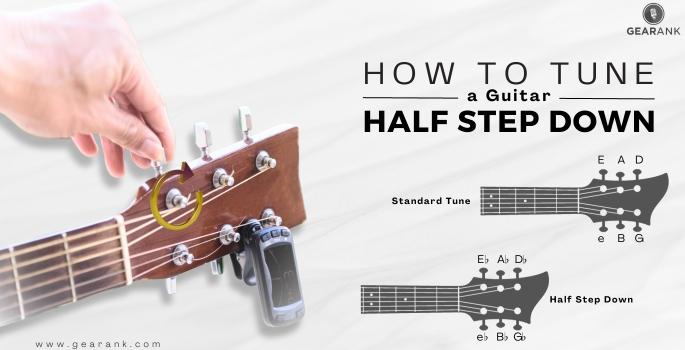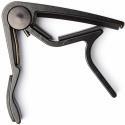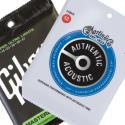How to Tune Half Step Down? It's Easier Than You Think

You might be familiar with a guitar's standard E, A, D, G, B, and e tuning, right?
But did you know that your guitar can be tuned lower than standard? One of the most popular tunings used in Rock is Eb (E♭) tuning, which is a half step down from standard.
If you want to know how to tune half-step down and its impact on your overall tone and playability, this article is for you.
Here I'm going to talk about:
-
What is Half Step Down Tuning?
-
Why Tune A Half Step Down?
-
Methods on How To Tune Half-Step Down
-
Tuning Tips
By the end, you'll be able to tune your guitar a half step down and understand why many iconic guitarists use this tuning.
What is Half Step Down Tuning?
Tuning half-step down means adjusting your guitar tuning a semitone lower from its original. A semitone in a guitar is represented by its individual fret spaces. So, tuning down a half-step is like moving your pitch 1 fret lower.
For example, a standard guitar tuning is in E A D G B e (e = high E string). So, if you tune your guitar a half step down, you'll have this tuning Eb Ab Db Gb Bb eb (E♭, A♭, D♭, G♭, B♭, and e♭).
Half-step-down tuning is applicable for both electric and acoustic guitars.
Why Tune A Half Step Down?
Tuning down a half step to E♭ is one of the most common alternate tunings. It's widely used in rock and metal, but you'll also see it used in other genres.
It serves a lot of purposes, from practical to musical. Below is a more detailed look at why musicians tune down a half step.
Ease for Singers - A guitar tuned a half step down is beneficial for singers. Lowering the pitch can help reduce the stress of reaching for high notes. And this is especially important for those who sing regularly.
Singing day after day can really put a strain on a singer's voice. So, in order to relieve some of the vocal strain, you can tune your guitar a half-step down, along with the other instruments.
Ease for Guitar Players: In relation to adjusting to the singer, tuning down a half step also benefits you as a guitar player. This lets you match the vocal pitch while still playing the same chord shapes and positions.
Tuning down a half step also means lowering the string tension. This means fretting and plucking are easier because of the slackened strings.
Eb tuning is also commonly used by those who want to play heavier gauge strings. The lower pitch lets you play heavy gauge strings with less tension.
Covering Songs: Many rock songs are tuned down a half-step, like Jimmy Hendrix's "Little Wing" or Guns N' Roses' "Paradise City". Tuning your guitar this way makes replicating or covering those songs easier.
Variation in Tone: Tuning down a half step can make your strings sound grittier and darker. Power chords have a richer sound because of the lower string tension. This is especially true when playing on Stratocasters with their 25.5" scale neck and single-coil pickups. Note that this warmer sound is not everyone's cup of tea, as you will lose some of the innate brightness of your guitar.
Methods on How To Tune Half-Step Down
Method #1: Using a Tuner
The most straightforward way is to use a guitar tuner. There are a lot of tuners available today, from clip-on tuners to tuner pedals and even downloadable mobile chromatic tuner apps.
Do the following to tune your guitar a half step down using a tuner.
-
Turn ON your guitar tuner or open the mobile application.
-
Next, pluck the strings one by one while observing the tuning pin or LED display on your tuner.
-
Tune your guitar from the low E string to E♭, A♭/G#, D♭/C#, G♭/F#, B♭, and e♭.
Method #2: Down-Tune Your Guitar Using a Reference
-
Play your desired half-step-down note E♭, for example) using a keyboard or another instrument.
-
Adjust the tuning pegs to match your guitar's sound to the reference note.
-
Start with the low E string going up to the high e string.
Method #3: Using the 4th and 5th Fret References
Assuming all the strings are in standard tuning, here's how you down-tune your guitar using the 4th and 5th fret reference method:
-
Press the 4th fret on the low E string and match the open 5th string to its pitch.
-
Press the 5th fret on the A string and match the open 4th string to its pitch.
-
Press the 5th fret on the D string and match the open 3rd string to its pitch.
-
Press the 4th fret on the G string and match the open 2nd string to its pitch.
-
Press the 5th fret on the B string and match the open 1st string to its pitch.
-
Match the open 6th string (low E string) to the open 1st string (high E string).
Tuning Tips
-
Drop D is another drop-tuning option. But it refers to tuning your guitar a whole step down instead of a half step down.
-
You can still play standard tuning chord shapes on a half-step down-tuned guitar. All you need to do is clip a capo on the first fret. Your open strings will now coincide with standard tuning, and the same goes with the chord shapes.
-
When playing with a band, ensure you are aware of your half-step down-tuned guitar. If the band is playing standard tuning, use a capo as mentioned above. If you can't convince your band to go half-step down, your best course of action is to tune your guitar to match the band's pitch.
-
Installing thicker strings will need wider nut slots. It will also need a truss rod as well as an action adjustment to compensate for the new strings. So when switching to thicker strings, it's important to set up your guitar or have it set up by a professional.
Final Thoughts
Knowing how to tune a half-step down will allow you to be more flexible when it comes to pitch.
It is a great entryway into the world of down-tuning and alternate tunings, which you can use to add new texture and flavor to your guitar sound.
This tuning will also make playing easier and allow for heavier gauge sets. It can also be helpful for vocalists who want to sing in a slightly lower and comfortable pitch.
Remember the basic standard tuning, and work your way down a half-step.
Try tuning your guitar a half step down and see for yourself how it changes your guitar sound and tone.
Frequently Asked Questions
Can I Use Standard Chord Shapes And Scales In Half Step Down Tuning?
Yes, you can use the same chord shapes and scales in a half-step down-tuned guitar. However, the appropriate pitch will be a semitone lower. Note that certain chords that don't use open strings will still work like how they do in standard tuning. Thankfully, Eb tuning is not as complex as alternative tuning, where chord shapes and scale changes. This same principle applies to 7 string tuning.
Will Tuning My Guitar Half Step Change Its Intonation?
Yes, it will change your guitar's intonation. Although it might be small, it's still important to check and make adjustments as needed. In some cases, more precise tuning or a guitar setup maybe needed.
Can I Tune A Bass Down a Half Step?
Yes, the same methods can also be applied when tuning your bass guitar a half-step down. Tuning down a half step in rock music usually requires all the band members to tune a half step down.
What Bands Use Half-Step Tuning?
Bands known to have used a half-step tuning are Guns N' Roses, Nirvana, Alice and Chains, Soundgarden, and Van Halen (debut album), among many others.
Contributors:
Jerome Arcon - Co-writer
Jerry Borillo - Illustrator












